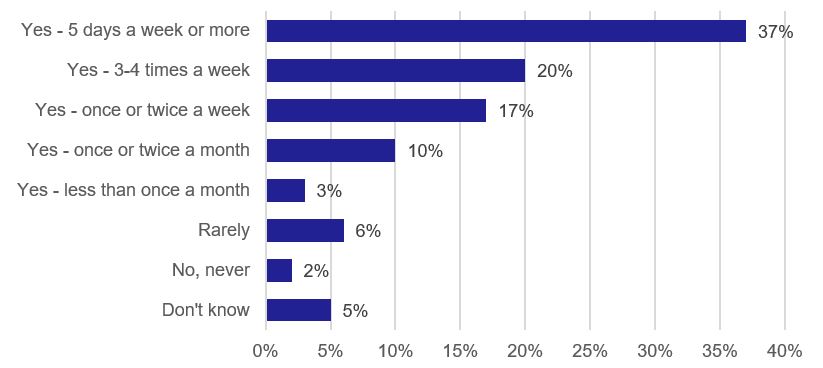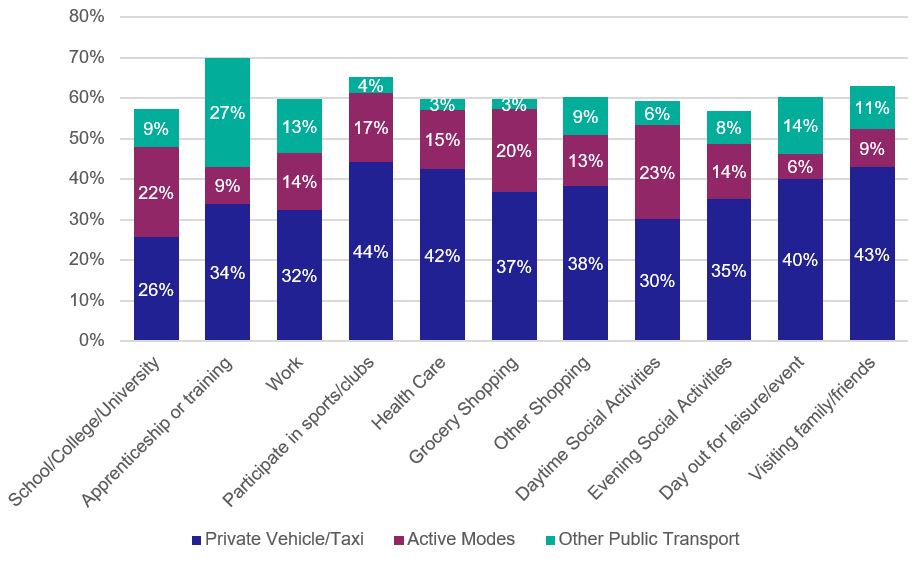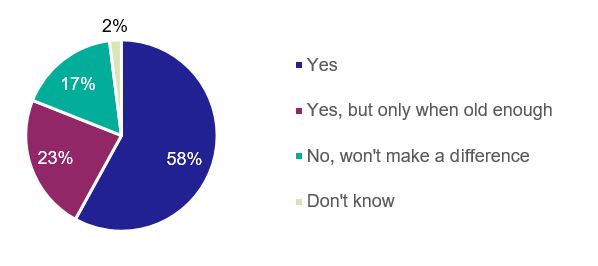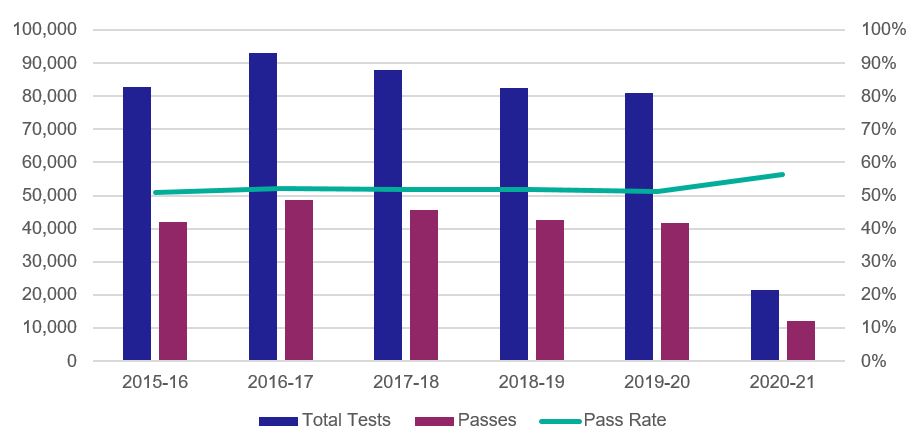Awareness, perceptions and expected use of the Young Persons’ Free Bus Travel Scheme
Awareness of the Young Persons’ Free Bus Travel Scheme
All respondents were asked if they/their child had heard about the Young Persons’ Free Bus Travel scheme before taking part in the survey. Of the 17,362 respondents who answered the question, around two thirds (67%) noted that they had heard of it, compared to 28% who had not and 5% who were not sure.
Expected Use of the Young Persons’ Free Bus Travel Scheme
Respondents were also asked to estimate how often they/their child was likely to use the Young Persons’ Free Bus Travel scheme after it was introduced. Of the 17,389 respondents who provided a response, over a third (37%) thought they would use it at least five days a week, with a further 38% suggesting they would use it at least once a week. Only 8% of respondents thought they would use it rarely or not at all.

Those who indicated they/their child would rarely or never use the Young Persons’ Free Bus Travel scheme were asked to outline their reasons for this.
The main reasons given for not using the free bus travel were similar to the barriers outlined above - i.e. that respondents lived in an area not well served by bus services, that the existing services do not go where and when the child/young person would need/want, reliability issues, and concerns over being exposed to anti-social behaviour/safety concerns. Several noted that they would either have to, or preferred to use the car, with a few noting that other public transport modes were more convenient or that they/their child was able to/preferred to walk wherever they needed to go. The age and ability of the child was also a factor, with some indicating that they would not let younger children travel by bus unaccompanied, or that those with autism or other issues were unable to travel alone:
He is too young to use the bus alone and I wouldn’t use the bus with him - they are far too expensive, unreliable and inconvenient.”
There was also some evidence, however, that the need for accompanying adults to pay a full fare would be prohibitive for some:
He is only 5 so will need me with him and I can’t afford the adult ticket price.”
He’s not confident enough and won’t use them without me and I can’t afford the price of a ticket for myself.”
Many simply indicated that they didn’t use the bus or would have no need to use the bus for their current lifestyle. However, a few did note that they could see the value of the free bus travel for others, or that they might make more use of it in future, for example, after they left school. This corresponds with earlier findings which showed that just over half of those undertaking an apprenticeship/training and those in work were using the bus for such journeys.
Expected Use by Journey Type
Those who indicated that they/their child would likely use the Young Persons’ Free Bus Travel scheme were asked to indicate which journey types they would use this for. Table 10 below details the results and shows that expected use as a direct result of the free travel ranged from 40% for those travelling to education, to 57% who thought they would use it for daytime social activities and for days out. The table also highlights the current bus use rate and the expected rate after the Young Persons’ Free Bus Travel scheme is implemented, and shows that, across all journey types the total expected bus use represented an increase on current levels, increasing from 21 percentage points for Apprenticeship/Training Programme (where bus use was already high), to 45 percentage points for travel to/from school/college/ university. Bus use for all social and leisure journeys (where travel by bus is currently lower than for work and training) is also expected to increase.
| Journey Purpose | Will use bus because it's free | Would have used bus anyway | Will not use bus | Don't know | Total | Expected Bus Use After Implementation | Current Bus Use | Percentage Point Difference |
|---|---|---|---|---|---|---|---|---|
| School/College/ University | 40% | 35% | 20% | 5% | 12,124 | 75% | 30% | 45 |
| Apprenticeship/ Training Programme | 47% | 28% | 10% | 15% | 4,842 | 75% | 54% | 21 |
| Work/Job | 48% | 32% | 11% | 9% | 7,774 | 80% | 51% | 29 |
| Sports/Clubs or Other Activities | 51% | 19% | 16% | 14% | 12,152 | 70% | 27% | 43 |
| Health Care | 39% | 23% | 25% | 13% | 12,126 | 62% | 31% | 31 |
| Grocery Shopping | 35% | 20% | 34% | 11% | 11,249 | 55% | 26% | 29 |
| Other Shopping | 53% | 26% | 12% | 9% | 12,879 | 79% | 37% | 42 |
| Social Activities (day) | 57% | 24% | 8% | 11% | 13,347 | 81% | 37% | 44 |
| Social Activities (evening/night) | 44% | 20% | 20% | 16% | 12,834 | 64% | 33% | 31 |
| Day Out for Leisure/ Event | 57% | 22% | 8% | 13% | 13,476 | 79% | 36% | 43 |
| Visiting Family/ Friends | 48% | 22% | 18% | 12% | 13,086 | 70% | 30% | 40 |
The data was also disaggregated by current travel modes for each journey purpose in order to establish the extent to which respondents expected to switch to bus use from cars, trains and active travel modes as a result of the Young Persons’ Free Bus Travel scheme. Figure 11 below outlines those respondents who currently use private vehicles/taxis, active modes, and other public transport options (including train, subway, tram and ferry) but indicated that they would start using the bus as it was free. This shows that between 26% and 44% of respondents would be likely to shift to bus use from private vehicles/taxis across all journey purposes. The largest impacts on active modes were expected to be for daytime social activities and travel to education, where 23% and 22% respectively would be likely to start using the bus after the free travel was introduced. Meanwhile, the biggest change in public transport use was expected to be in travel to/from an apprenticeship or training programme, where 27% of respondents would be expected to switch to bus use.

To establish the expected impact on whether young people will be able to/will access new opportunities, respondents were asked if the Young Persons’ Free Bus Travel scheme would encourage them/their child to make more journeys and/or start travelling to new places. Table 11 details the results and shows that between 51% (for health care) and 80% (for daytime social activities) of respondents felt that the Young Persons’ Free Bus Travel scheme would allow them to travel more often to their current destinations, and/or to access new destinations.
| Journey Purpose | More journeys to the same places | Travel to new places | Both more journeys and new places | Won't change | Don't know | Total |
|---|---|---|---|---|---|---|
| School/College/ University | 39% | 13% | 13% | 31% | 4% | 8,704 |
| Apprenticeship/ Training Programme | 28% | 25% | 17% | 21% | 9% | 3,250 |
| Work/Job | 32% | 18% | 16% | 28% | 6% | 5,715 |
| Sports/Clubs or Other Activities | 25% | 27% | 24% | 17% | 7% | 8,037 |
| Health Care | 32% | 10% | 9% | 42% | 7% | 7,096 |
| Grocery Shopping | 30% | 21% | 19% | 26% | 4% | 5,901 |
| Other Shopping | 25% | 22% | 24% | 23% | 6% | 9,622 |
| Social Activities (day) | 23% | 27% | 30% | 14% | 6% | 10,392 |
| Social Activities (evening/night) | 25% | 24% | 26% | 18% | 7% | 7,874 |
| Day Out for Leisure/ Event | 19% | 27% | 33% | 14% | 7% | 10,231 |
| Visiting Family/ Friends | 40% | 12% | 19% | 24% | 5% | 8,773 |
Respondents were also asked if they thought that the Young Persons’ Free Bus Travel scheme would enable them/their child to travel and do more without an adult. Of the 15,198 who provided a response, over half (58%) felt that it would, and a further 23% agreed that it would, but only once they/their child was old enough.

Impact on Families
Parents/carers who were completing the survey were asked whether they thought the Young Persons’ Free Bus Travel scheme would encourage them to make more journeys as a family by bus. Of the 10,184 who provided a response, just under half (46%) felt this would encourage more family journeys to be made by bus, while 27% felt it would not. The remaining 27% did not know.
Impact on Families – Demographic Analysis
Urban/Rural/Island
- The more urban the area the more likely it was that respondents felt the scheme would encourage them to make more journeys as a family by bus - those in cities were nearly twice as likely than those living on islands to think this (56% vs 31% respectively).
Disability
- Those whose activities were limited by a health condition, were slightly more likely to indicate that the scheme would encourage them to make family trips by bus compared to those who did not have a health issue (51% vs 46% respectively).
Income
- As household income rose, respondents were less likely to think the scheme would encourage bus use for family trips - those with the lowest income (i.e. less than £10,000) were nearly twice as likely to indicate that this would encourage them to make more family trips compared to those in the highest income group (i.e. £100,000 or more) (67% vs 35% respectively).
Other Factors
- Number of private vehicles available for household use had a significant impact on intentions, with 71% of those with no cars available indicating the scheme would encourage more family bus journeys compared to just 26% of those with 3 or more cars.
- LGBT young people were more likely to indicate that the scheme would encourage more family journeys by bus compared to straight/heterosexual respondents (56% vs 39% respectively).
- Those from black and ethnic minority groups were more likely to indicate that the scheme would encourage more family journeys by bus compared to those from white ethnic groups (61% vs 45% respectively).
Those who indicated it would encourage them to make more journeys by bus, were asked to outline what type of journeys and why they would use the bus, while those who said it would not make a difference were asked to explain why.
Encouraging Family Travel
In total, 5,118 respondents indicated that the Young Persons’ Free Bus Travel scheme would encourage them to make more journeys as a family by bus and outlined what type of journeys they would make and why they would use the bus.
Affordability was the main reason given for increasing family trips as a result of the Young Persons’ Free Bus Travel scheme. It was felt that families would find it easier and more affordable to do things together. Other factors included removing the challenges of finding and paying for parking:
Yes, because sometimes I don't have enough money to put on my card to take all the children to the town, etc.”
As I have [multiple] children and having to pay for each of them and then myself can be quiet dear, so having them getting a free pass would make it so much more affordable for myself to go new places and take them out more.”
Would take the bus into town instead of taking the car as I’d only have one fare to pay instead of 3 which would make it cheaper than paying for parking. Currently it is more expensive to take the bus.”
A wide range of different journey purposes were outlined by respondents, including local travel and using the Young Persons’ Free Bus Travel scheme to allow the family to reach urban hubs and other more distant and new locations. There was a strong desire for family days out and leisure trips (covering a wide range of activities), as well as visiting family and friends. Shopping and going out for meals were also commonly identified. Several also indicated they would use the Young Persons’ Free Bus Travel scheme as a family for travel to/from school, and/or to access after school clubs and activities. A few also suggested that the free travel would support holidays taken across Scotland:
Zoo, museums, children's events. We don't have a car, so bus are our preferred choice of travel within the city and if it's free it's even better for us.”
School journeys, days out, visiting family.”
Would visit further away places as it won't cost as much.”
Would travel different places go site seeing places we've never been before.”
No Change to Family Travel
Conversely, 2,679 respondents indicated that the Young Persons’ Free Bus Travel scheme would not encourage them to make more journeys as a family by bus and outlined their reasons for this.
Largely, this was due to the cost of the adult fares still being considered to be too expensive. Some felt it would still be more cost effective to drive or use other modes of public transport compared to adult fares on the bus:
Adult fares are still too expensive. Still cheaper to park than a return bus fare into town.”
Adult cost will be too high, equivalent local journey by train is cheaper. Child was half price anyway.”
Because as a family it is still expensive even with child free travel. £10 a journey.”
Other key issues for many respondents, again mirrored the barriers and safety issues discussed above. This included:
- the lack of any bus services locally, or the lack of frequent and reliable services. These respondents again noted that either the routes or times of buses available locally were not suitable or convenient, or that the journey’s took too long or were regularly delayed or cancelled
- safety concerns around on-board travel, travel to/from the bus stop, and at stop safety
- a lack of direct routes and joined-up services, and
- travel sickness:
There are no suitable routes or times from our village.”
Because I'd still have to pay and buses are generally slow, uncomfortable, inconvenient.”
Because of cold bus, unreliable bus service, take too long, need to take more than 1 bus, and the cost of fare.”
The quality of the on-board environment was also discussed here, with several respondents noting that buses were often ‘dirty’, ‘smelly’, ‘uncomfortable’ and had window’s that did not open. The need to have the exact fare was also mentioned by a few respondents as a reason for not travelling more by bus.
Again, many indicated that they would continue to drive - either through necessity, convenience or preference. Similarly, concerns over COVID-19 were raised again as a reason for not using the bus more often as a family.
Finally, a few respondents noted that, as they already used the bus a lot, this would have little impact on their overall travel patterns as a family, it would simply make it more affordable. Others, with older children indicated that their children wanted to spend time with friends rather than their parents and therefore, again, the Young Persons’ Free Bus Travel scheme would have little impact on family travel patterns:
We already use the bus fairly regularly but kids going free will be a bonus.”
Learning to Drive
In order to provide a measure which could help determine any future impact of the Young Persons’ Free Bus Travel scheme on if and when young people might start learning to drive, respondents in the age category 16-21 (and parents/carers who were responding on their behalf) were asked if they drove or were learning to drive. Of the 1,752 respondents who were age 17 and above (i.e. old enough to start driving) who provided a response, just under half (48%) indicated they either drove or were currently taking lessons, while just over half (52%) were not. While this provides a baseline measure of the current situation, any post-implementation assessment would need to need to confirm the extent to which the Young Persons’ Free Bus Travel scheme had impacted on when/if they learned to drive (rather than other external factors).
Note: Analysis of this question was based on unweighted data as only one age group responded.
| Journey Purpose | Yes - Drive or Taking Lessons | No - Do not drive or taking lessons | Total |
|---|---|---|---|
| Age 17 | 47% | 53% | 1,011 |
| Age 18 | 50% | 50% | 311 |
| Age 19 | 47% | 53% | 204 |
| Age 20 | 44% | 56% | 141 |
| Age 21 | 56% | 44% | 85 |
| Total | 48% | 52% | 1,752 |
The Scottish Household Survey also provides a measure of the proportion of young people aged 17-19 who hold a full driving licence. This shows that young people in this age group had been obtaining driving licences in greater proportions between 2015 and 2019 - 26% held a full driver’s licence in 2015 rising to 39% in 2019. This compares to the 48% on average in the 17-19 age group who were learning to drive or held a licence in the current survey.
In addition, the Driver and Vehicle Standards Agency (DVSA) provides data on the number of tests taken in Scotland for those aged 17-25. This shows slightly declining numbers of tests taken between 2016/17 and 2019/20, and a significant decline in 2020/21, presumably due to the COVID-19 restrictions.

< Previous | Contents | Next >